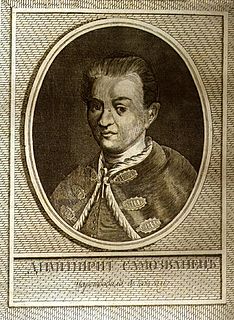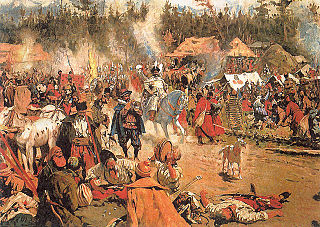
Field Marshal and Count Jacob Pontusson De la Gardie was a statesman and a soldier of the Swedish Empire, and a Marshal from 1620 onward.

The Time of Troubles, or Smuta, was a period of political crisis during the Tsardom of Russia which began in 1598 with the death of Fyodor I and ended in 1613 with the accession of Michael I of the House of Romanov.

The Ingrian War between the Swedish Empire and the Tsardom of Russia lasted between 1610 and 1617. It can be seen as part of Russia's Time of Troubles and is mainly remembered for the attempt to put a Swedish duke on the Russian throne. It ended with a large Swedish territorial gain in the Treaty of Stolbovo, which laid an important foundation to Sweden's Age of Greatness.

False Dmitry I reigned as the Tsar of Russia from 10 June 1605 until his death on 17 May 1606 under the name of Dmitriy Ivanovich. According to historian Chester S.L. Dunning, Dmitry was "the only Tsar ever raised to the throne by means of a military campaign and popular uprisings".

Vasili IV Shuisky was Tsar of Russia between 1606 and 1610 after the murder of False Dmitri I. His rule coincided with the Time of Troubles. He was the only member of House of Shuisky to become Tsar and the last member of the Rurikid dynasty to rule as tsar.

The Polish–Russian War of 1609–1618, also known as the Polish–Muscovite War or the Dimitriads, was a conflict fought between the Tsardom of Russia and the Polish–Lithuanian Commonwealth from 1609 to 1618.

The De la Gardie campaign was a joint military campaign by the Tsardom of Russia and Sweden during the Polish–Muscovite War from April 1609 to June 1610.

Ivan Isayevich Bolotnikov (1565-1608) headed a popular uprising in Russia in 1606–1607 known as the Bolotnikov Rebellion. The uprising formed part of the Time of Troubles in Russia.
Tsaryovo-Zaymishche is a village in Vyazemsky District of Smolensk Oblast, Russia, situated on the old road from Smolensk to Moscow, west of Vyazma. In the 17th century, the village was a place where travellers to Moscow were examined by Russian custom officials and police.

The Battle of Dobrynichi took place on 21 January 1605 between the armies of False Dmitry I and Fyodor Mstislavsky near the village of Dobrynichi.

Boris Godunov is a closet play by Alexander Pushkin. It was written in 1825, published in 1831, but not approved for performance by the censor until 1866. Its subject is the Russian ruler Boris Godunov, who reigned as Tsar from 1598 to 1605. It consists of 25 scenes and is written predominantly in blank verse.

The Battle of Moscow was a series of two battles, which took place in Moscow, on September 1 and 3, 1612, during the Polish–Muscovite War (1605–18). Forces of the Polish–Lithuanian Commonwealth were commanded by Field Hetman of Lithuania, Jan Karol Chodkiewicz, while Russians were led by Dmitry Pozharsky. The battles ended in tactical Russian victory.

The siege of Kromy was the last major clash of government troops of Boris Godunov with the rebel army of False Dmitry I.

The battle of the Bear's Ford took place in June 1608, when a government army of Boyar Ivan Kurakin defeated Lithuanian Colonel Alexander Lisowsky, in service of False Dmitry II.

In the Battle of Zaraisk, during the Time of Troubles, on April 9, 1608, Colonel Alexander Lisovsky in service of False Dmitry II, defeated the army of Tsar Vasily IV under Zahariya Lyapunov and Ivan Khovansky.

In the Battle of Bolkhov on May 10–11, 1608, the troops of False Dmitry II managed to defeat the army of Tsar Vasily Shuisky.

The Battle of Kozelsk was the first victory of False Dmitry II against the government of Tsar Vasili IV Shiuski.

The Battle of Mozhaysk was a series of battles at the final stage of the Polish-Muscovite War (1605-1618) on the western approaches to Moscow. The battle is part of the Moscow campaign of Wladyslaw IV. During months of fighting, the Russian armies managed to maintain their combat capability and prevent the rapid seizure of Moscow. However, the threat of encirclement forced the Russian troops to retreat, opening the way for the enemy to the capital.

The Battle of Bronnitsy was part of the Ingrian War.
Prince Vasily Vasilievich Golitsyn was a Russian commander, nobleman and governor. Golitsyn was a prominent figure during the Time of Troubles between 1587 and 1613.














